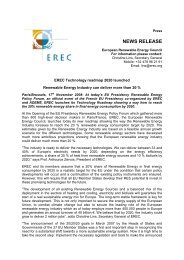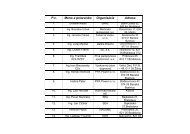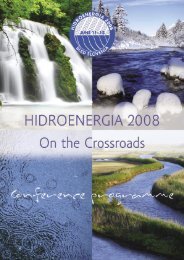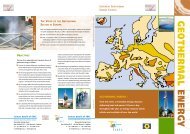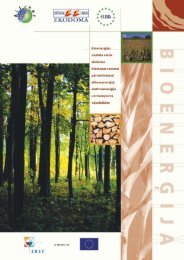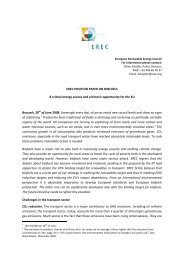Geothermal - European Renewable Energy Council
Geothermal - European Renewable Energy Council
Geothermal - European Renewable Energy Council
You also want an ePaper? Increase the reach of your titles
YUMPU automatically turns print PDFs into web optimized ePapers that Google loves.
<strong>European</strong><br />
<strong>Geothermal</strong><br />
<strong>Energy</strong><br />
<strong>Council</strong><br />
GEOTHERMAL<br />
ELECTRICITY<br />
AND COMBINED<br />
HEAT & POWER
<strong>European</strong><br />
<strong>Geothermal</strong><br />
<strong>Energy</strong><br />
<strong>Council</strong><br />
<strong>Geothermal</strong> Electricity and<br />
Combined Heat & Power<br />
Content<br />
Page<br />
Introduction 3<br />
<strong>Geothermal</strong> Power Systems 4<br />
Dry steam and Flash power plants 5<br />
Binary cycle power plants 6<br />
<strong>Geothermal</strong> CO 2<br />
8<br />
<strong>Geothermal</strong> electricity history 9<br />
<strong>Geothermal</strong> electricity in Europe 10<br />
<strong>Geothermal</strong> electricity worldwide 12<br />
Combined Heat and Power 13<br />
EGEC | <strong>Geothermal</strong> Electricity and Combined Heat & Power
Introduction<br />
<strong>Geothermal</strong><br />
manifestation<br />
<strong>Geothermal</strong> energy is the heat from the<br />
Earth, or, more precisely, that part of<br />
the Earth’s heat that can be recovered<br />
and exploited by man. Evidence of terrestrial<br />
heat is given by volcanoes, hot springs, and<br />
other thermal manifestations. Early mine excavations<br />
showed that the Earth’s temperature<br />
was increasing with depth, under a gradient<br />
of a 2-3°C/100m. The total heat flux from the<br />
Earth’s interior amounts to ca 80 mW th<br />
/m 2 . It<br />
provides us with an abundant, non-polluting,<br />
almost infinite source of clean and renewable<br />
energy. The heat originates from the Earth core<br />
temperature (4,000°C at 6,000 km depth) and<br />
the radioactive decay of rocks, long life isotopes<br />
of Uranium, Thorium and Potassium.<br />
The total heat content of the Earth stands in the<br />
order of 12.6 x 10 24 MJ, and that of the crust<br />
of 5.4 x 10 21 MJ, indeed a huge figure when<br />
compared to the total world energy demand<br />
which amounts to ca 610 13 MJ/yr i.e. a 100<br />
million times lower. However, only a fraction<br />
of it can be utilised by man. Our utilisation of<br />
this energy has been limited to areas in which<br />
geological conditions allow a fluid (liquid water<br />
or steam) to “transfer” the heat from deep hot<br />
zones to, or near, the surface, thus giving rise<br />
to geothermal resources.<br />
The heat outflows from the Earth’s core melting<br />
the rocks, forming the magma. Then, the magma<br />
rises toward the Earth’s crust, carrying the heat<br />
from below through convective motions. It may flow<br />
as lava, smoothly or explosively, at the surface.<br />
In some areas it remains below the crust, heating<br />
the surrounding rocks and hosted waters. Some<br />
of this hot geothermal water migrates upwards,<br />
through faults and cracks, reaching the surface<br />
as hot springs or geysers, but most of it remains<br />
underground, trapped in cracks and porous rocks,<br />
forming the geothermal reservoirs. In such locations<br />
the geothermal heat flow can reach values<br />
ten times higher than normal.<br />
Under standard conditions 30 to 50°C temperatures<br />
would be expected at 1 to 1.5 km depths;<br />
in geothermal areas enjoying higher than normal<br />
heat flows, temperatures are likely to reach 100<br />
to 150°C at similar depths. In areas close to<br />
lithospheric plate margins, geothermal resources<br />
would display a wider temperature range, from<br />
150°C to very high values, ultimately culminating<br />
at 400°C and supercritical fluid state.<br />
Utilization of<br />
geothermal fluid<br />
Graph from <strong>Geothermal</strong><br />
Education Office, California<br />
EGEC | <strong>Geothermal</strong> Electricity and Combined Heat & Power 3
<strong>Geothermal</strong> Power<br />
Systems<br />
<strong>Geothermal</strong> power plant distribution<br />
Schematically, a geothermal system may<br />
be described as convective water in the<br />
Upper Earth crust, transferring heat, in<br />
a confined state, from a heat source to a heat<br />
sink (usually a free surface). Hence, a geothermal<br />
system includes three components, a heat<br />
source, a reservoir and a heat carrier fluid.<br />
8 %<br />
64 %<br />
28 %<br />
The heat source can be either a magmatic<br />
intrusion at very high temperature at relatively<br />
shallow depths (5 to 10 km) or simply, in case of<br />
low temperature systems, hot rocks at depth.<br />
Dry Steam<br />
Flash<br />
Binary<br />
Schematic representation<br />
of an ideal geothermal<br />
system.<br />
The reservoir consists of hot permeable rocks<br />
from which circulating fluids extract heat. The<br />
reservoir is generally overlain by impervious cap<br />
rocks and connected to a superficial outcropping<br />
area subject to meteoric recharge, which<br />
replaces, at least in part, the fluids abstracted<br />
through spring or/and well discharge as depicted<br />
in the attached sketch.<br />
The geothermal fluid is water, most often of<br />
meteoric origin, in either liquid or vapour phase<br />
depending on its temperature and pressure. The<br />
geothermal water often contains dissolved chemicals<br />
and gases such as CO 2<br />
, H 2<br />
S, etc…<br />
Hot water and steam are extracted by drilling<br />
wells into reservoir thus enabling to exploit this<br />
clean and sustainable resource. In this respect,<br />
a reliable expertise and engineering skills have<br />
been developed in order to achieve relevant reservoir<br />
assessments and drilling locations. Once<br />
available at production well heads, geothermal<br />
fluids can be used for electric power generation<br />
or non-electric (direct uses) heating purposes<br />
or both (combined heat and power).<br />
Power plants need steam to generate electricity.<br />
The steam rotates a turbine that activates a<br />
generator (alternator), thus producing electricity.<br />
Conventional power plants burn fossil fuels to boil<br />
water. <strong>Geothermal</strong> power plants, instead, use steam<br />
produced from geothermal reservoirs, located at<br />
several hundred to a few thousand meters below<br />
ground. This steam production process does not<br />
requires any artificial nor natural combustion<br />
whatsoever, i.e. it avoids man-induced CO 2<br />
emissions. There are three types of geothermal<br />
power plants, dry steam, flash steam and binary<br />
cycle respectively.<br />
Largest installed capacities correspond to flash<br />
plants (64%) (see plant distribution diagramme);<br />
binary units, despite their presently low ranking<br />
(8%), due to smaller plant ratings, raise fast<br />
growing interest as they address widespread, low<br />
to medium temperature, resource settings.<br />
A total of ca 500 geothermal units were reported<br />
online in 2007. The maximum addresses about<br />
250 binary plants, totalling a 800 MW e<br />
installed<br />
capacity (i.e. a unit 3,3 MW e<br />
plant load). The sizes<br />
of flash and dry steam plants average 31 MW e<br />
and 44 MW e<br />
respectively.<br />
4 EGEC | <strong>Geothermal</strong> Electricity and Combined Heat & Power
Dry steam and<br />
Flash power plants<br />
Dry steam power plants utilise straightforwardly<br />
steam, which is piped from<br />
production wells to the plant, then directed<br />
towards turbine blades. The first, ever exploited,<br />
geothermal field, still in operation, at Larderello<br />
in Italy, is among the very few drysteam fields<br />
recorded worldwide.<br />
Flash steam power plants<br />
Conventional drysteam turbines require fluids<br />
of at least 150°C and are available with either<br />
atmospheric (backpressure) or condensing<br />
exhausts. In the backpressure system steam is<br />
passed through the turbine and vented to atmosphere.<br />
This cycle consumes twice more steam<br />
per produced kilowatt-hour (kWh), at identical<br />
turbine inlet pressure, than a condensing cycle.<br />
However backpressure turbines may prove<br />
rewarding as pilot or/and stand by plants in case<br />
of small supplies from remote isolated wells and<br />
for generating electricity in the early stages of field<br />
development. They become mandatory in case<br />
of high non condensable gas contents, in excess<br />
of 12% in weight, in the vapour phase.<br />
The steam, separated from the water, is piped to<br />
the plant to drive a turbo-alternator. The separated<br />
left over brine, together with the condensed<br />
steam, is piped back into the source reservoir, an<br />
injection process meeting waste disposal, heat<br />
recovery, pressure maintenance and, last but not<br />
least, resource sustainability requirements.<br />
Berlin 44 MW<br />
flash power plant -<br />
El Salvador.<br />
Condensing units are more complex in design,<br />
requiring more ancillary equipment and space and<br />
up to twice long construction/installation delays.<br />
Turbine specific steam consumption varies from<br />
8 to 10 t/h depending on temperature and pressure.<br />
55 to 60 MW e<br />
plant installed capacities are quite<br />
common but, recently, 110 MW e<br />
plants have been<br />
commissioned and are currently operating.<br />
Flash steam plants, by far the most common,<br />
address water dominated reservoirs and temperatures<br />
above 180°C. The hot pressurised water<br />
flows up the well until its pressure decreases to<br />
the stage it vaporises, leading to a two phase<br />
water-steam mixture and a vapour lift process.<br />
Larderello standard unit<br />
of 20 MW dry steam<br />
power plant - Italy<br />
EGEC | <strong>Geothermal</strong> Electricity and Combined Heat & Power 5
Binary cycle power plants<br />
Binary, known also as organic Rankine<br />
cycle (ORC), plants operate usually with<br />
waters in the 100 to 180°C temperature<br />
range. In these plants, the heat is recovered<br />
from the geothermal fluid, via a heat exchanger,<br />
to vaporize a low boiling point organic fluid<br />
and drive an organic vapour turbine. The heat<br />
depleted geothermal brine is pumped back into<br />
the source reservoir, thus securing sustainable<br />
resource exploitation. Since the geothermal<br />
and working fluids are kept separated during<br />
the process there are little if any atmospheric<br />
emissions. Adequate working fluid selection may<br />
allow to extend the former design temperature<br />
range from 180°C to 75°C.<br />
Upper and lower temperature limits depend on<br />
the organic fluid stability and techno-economic<br />
considerations respectively. At low temperatures<br />
the size required by the heat exchangers could<br />
defeat project economic-viability. Apart from low<br />
to medium temperature utilisation, geothermal<br />
and waste fluid binary process can be contemplated<br />
to avoid well scaling damage further to<br />
in-hole flashing, in which case submersible<br />
pumps are used to produce the geothermal<br />
fluid under pressure.<br />
Binary power<br />
plants.<br />
Binary processes are emerging as a cost effective<br />
conversion technology for recovering<br />
power from, water dominated, geothermal<br />
fields at temperatures below 180°C Recently,<br />
a new candidate binary process, known as the<br />
Kalina cycle, has been developed displaying<br />
attractive conversion efficiencies. It’s distinctive<br />
features address an ammonia-water working<br />
fluid mixture and regenerative heating. In brief,<br />
it takes advantage of the low boiling point of the<br />
water-ammonia mixture to allow a significant<br />
fraction of it to be vaporised by the excess<br />
heat available at turbine exhaust. The gains<br />
over conventional ORC plant efficiencies have<br />
been estimated at 40%, although its reliability<br />
and performances are yet to be demonstrated<br />
on long terms plant service.<br />
Reclamation of low temperature geothermal<br />
sources, achievable via binary cycles, can significantly<br />
increase the overall worldwide exploitation<br />
potential. Small scale geothermal binary plants<br />
(< 5 MW e<br />
ratings) can be widely implemented in<br />
rural areas and, more generally, respond to an<br />
increasingly disseminated human demand.<br />
6 EGEC | <strong>Geothermal</strong> Electricity and Combined Heat & Power
10 MW e<br />
Ribeira<br />
Grande binary<br />
unit - Azores<br />
Islands.<br />
Binary systems represent a means for upgrading<br />
overall plant efficiencies of “conventional” flash<br />
cycles. Contrary to dry steam plants, where the<br />
water phase reduces to steam condensates,<br />
flash units produce large amounts of separated<br />
water and waste heat, which remains lost<br />
unless otherwise utilised as heat proper (space<br />
heating/process heat for instance) or as binary<br />
power downstream from the flash steam turbine.<br />
This power cascading scheme produces low<br />
cost energy extras at zero mining costs.<br />
200 kW e<br />
Chena<br />
hot spring binary<br />
unit using 74°C<br />
geothermal<br />
resource- Alaska<br />
2 MW e<br />
Husavik<br />
Kalina binary<br />
unit- Iceland<br />
EGEC | <strong>Geothermal</strong> Electricity and Combined Heat & Power 7
<strong>Geothermal</strong> CO 2<br />
<strong>Geothermal</strong> systems are located in areas<br />
exhibiting high CO 2<br />
fluxes inherent to<br />
the geology of geothermal host structures.<br />
In volcanic environments much higher<br />
CO 2<br />
fluxes are the rule.<br />
Natural generation<br />
of CO 2<br />
in geothermal<br />
systems<br />
For instance, in Italy, in the Central West Tyrrhenian<br />
region, large amounts of CO 2<br />
are produced<br />
at depth as a consequence of marine carbonate<br />
rock metamorphism. During their ascent, gases<br />
get trapped in deep seated structures including<br />
permeable mesozoic limestones overlain by<br />
impervious capping terrains, which become<br />
sources of high CO 2<br />
upward flows. For this<br />
reason, deep ground waters are enriched in<br />
dissolved CO 2<br />
. Metamorphic processes affecting<br />
carbonate phyllites can also contribute to<br />
CO 2<br />
production from shallow crustal levels at<br />
ca 8 km depths and 400-500°C temperatures,<br />
higher than those (3-4 km; 200-300°C) of the<br />
overlying geothermal reservoir.<br />
Larderello<br />
Noteworthy is that natural CO 2<br />
production is independent<br />
from geothermal exploitation. Actually,<br />
surface manifestations, characterised by hot<br />
water and steam discharges from springs and<br />
fractures, can create an environment hostile to<br />
human settlements (Larderello, Yellowstone).<br />
Thanks to industrial geothermal exploitation,<br />
deep, eventually toxic, geothermal fluids could be<br />
channelled, via geothermal wells and collecting<br />
lines, to power plants concentrating on a single<br />
point (the plant chimney) natural emissions which<br />
would otherwise contaminate the surrounding soils<br />
and atmosphere over much larger areas.<br />
Summing up, geothermal CO 2<br />
emissions are<br />
not generated by the industrial exploitation<br />
process.<br />
CO 2<br />
emission in electricity production<br />
<strong>Geothermal</strong>,<br />
natural emission<br />
122<br />
Natural Gas<br />
315<br />
Oil<br />
760<br />
Coal<br />
915<br />
0 100 200 300 400 500 600 700 800 900 1000<br />
CO 2<br />
emission g/kWh<br />
8 EGEC | <strong>Geothermal</strong> Electricity and Combined Heat & Power
First experiment<br />
to produce<br />
geothermal<br />
power, done<br />
in Italy in 1904<br />
by prince<br />
Ginori Conti<br />
<strong>Geothermal</strong> electricity history<br />
In the early 1900’s, geothermal fluids were<br />
already exploited for their energy content. A<br />
chemical industry was set up in Italy during<br />
that period, in the area known now as Larderello,<br />
to extract boric acid from natural hot water outlets<br />
or from purposely drilled shallow boreholes. From<br />
years 1910 to 1940 the low pressure steam,<br />
in that area of Central Tuscany, was utilised<br />
to heat industrial and residential buildings and<br />
greenhouses. In 1928, Iceland, another pioneer<br />
in the utilisation of geothermal energy, began<br />
exploiting its abundant geothermal resources<br />
(mainly hot waters) for domestic heating.<br />
This application, exemplified by Italy, was followed<br />
by several countries. In Japan, the first geothermal<br />
wells were drilled in 1919 and in 1929 at The<br />
Geysers, California, in the USA. In 1958, a small<br />
geothermal power plant started operating in New<br />
Zealand, in 1959 in Mexico, in 1960 in the USA,<br />
and in many other countries the following years.<br />
The first attempt to generate electricity from geothermal<br />
steam dates back to 1904 at Larderello.<br />
The success of this experiment (see illustration)<br />
proved the industrial value of geothermal energy<br />
and marked the beginning of an exploitation route<br />
that was developed significantly since then. Actually,<br />
electricity generation at Larderello was a<br />
commercial success. By 1942 the installed geothermoelectric<br />
capacity had reached 128 MWe.<br />
<strong>Geothermal</strong><br />
Book - Italy.<br />
Panorama<br />
Larderello -<br />
Today<br />
EGEC | <strong>Geothermal</strong> Electricity and Combined Heat & Power 9
<strong>Geothermal</strong> electricity in Europe<br />
As far as geothermal electricity is concerned<br />
the vast majority of eligible resources, in<br />
Continental Europe at large, is concentrated<br />
in Italy, Iceland and Turkey; the presently<br />
exploited potential represents so far 0.3% of the<br />
whole renewable energy market.<br />
There are two major geothermal areas in Italy,<br />
Larderello-Travale/Radicondoli and Monte Amiata<br />
respectively, achieving a 810 MW e<br />
installed<br />
capacity.<br />
They represent two neighbouring parts of the<br />
same deep seated field, spreading over a huge,<br />
ca 400 km 2 , area, which produces superheated<br />
steam. On the Larderello side the exploited area<br />
and installed capacity amount to 250 km 2 and<br />
562 MW e<br />
respectively. On the Travale/Radicondoli<br />
side, to the Southeast, the installed capacity is<br />
160 MW e<br />
and the exploited area 50 km 2 . The<br />
steam condensates recovered from Travale are<br />
reinjected into the core of the Larderello field,<br />
via a 20 km long water pipeline.<br />
The Monte Amiata area, in Northern Latium,<br />
includes two water dominated geothermal fields,<br />
Piancastagnaio and Bagnore. On both fields a deep<br />
resource has been identified under the shallow<br />
producing horizons. Weak social acceptance from<br />
the local communities are slowing down the full<br />
development of the promising, high potential, deep<br />
reservoir. Presently, five units are operating, one in<br />
Bagnore and four in Piancastagnaio, totalling a 88<br />
MWe installed capacity. Projects, adding a further<br />
100 MWe capacity, have been commissioned and<br />
will be completed in the near future.<br />
<strong>Geothermal</strong> resources in Iceland relate to the active<br />
volcanic environment of the island, located on<br />
the mid-Atlantic ridge and its sea floor spreading<br />
attributes. Iceland has proved a leading country<br />
in direct uses of geothermal energy, mainly in<br />
greenhouse and district heating (89% of the total<br />
domestic heating demand) and is increasing its<br />
electricity production which reached (@2006) a<br />
420 MW e<br />
installed capacity. Although significant<br />
this capacity ought to be compared to the huge<br />
potential of the island, estimated at ca 4000 MW e<br />
,<br />
a figure far above national power requirements,<br />
ca 1500 MW e<br />
, among which hydropower holds<br />
the dominant share (1300 MW e<br />
).<br />
Turkey’s geothermal resources are mainly located<br />
in Western Anatolia on the Aegean sea façade.<br />
District heating stands presently as the most<br />
important utilisation with 65000 heated homes.<br />
This, in spite of mild climatic conditions which still<br />
makes geothermal heat competitive as a result<br />
of the high cost of electric heating, 8 to 10 times<br />
higher than geothermal heat. Electricity production<br />
in the Kizildere water dominated field is supplied<br />
by a 15 MW e<br />
design plant (start up, 1988) capacity,<br />
actually standing at 12 MW e<br />
. Binary plants<br />
have been commissioned. The largest geopower<br />
(flashed steam) plant, rated 45 MW e<br />
, is presently<br />
in advanced construction stage, at Germencek.<br />
The geothermal electricity potential has been<br />
(conservatively) estimated at 200-300 MW e<br />
.<br />
In Greece, high temperature geothermal resources<br />
are located in the Aegean volcanic<br />
island arc, in the Milos (Cyclade) and Nisyros<br />
(Dodecanese) islands, thanks to direct drilling<br />
and testing assessments. Electricity generation<br />
from a 2 MW e<br />
rated pilot plant ceased further to<br />
the strong opposition of the local community and<br />
mismanaged communication by the geothermal<br />
operator. The country potential in the Aegean<br />
archipelagos and, at a lesser extent through, in<br />
the northern, mainland located, grabens<br />
is estimated at ca 200 MW e<br />
. Otherwise,<br />
several low temperature fields are<br />
exploited, on presently limited bases,<br />
for greenhouse heating and process<br />
heat applications.<br />
In Russia, geoelectric development took<br />
place in the Mutuovski field of Kamchatka<br />
which, although belonging politically to<br />
Europe, ought to be regarded as geogra-<br />
Iceland<br />
Krafla, Iceland<br />
10 EGEC | <strong>Geothermal</strong> Electricity and Combined Heat & Power
Larderello, Italy Larderello, Italy<br />
phically Asian. Here, exploration which started in<br />
the mid 1980’s, identified an important potential<br />
(ca 200-300 MW e<br />
) from a superheated, shallow<br />
seated, geothermal system. Following an early<br />
12 MW e<br />
pilot plant phase, a 50 MW e<br />
rated unit<br />
was commissioned and operated online. Whenever<br />
restricted to the sole Kamchatka peninsula<br />
and its geological extension to the southern<br />
Kuril islands, the projected Russian installed<br />
capacity of geothermal electricity is limited to<br />
80 MW e<br />
. Otherwise, direct uses, amounting to<br />
327 MW e<br />
, are widely developed in space heating<br />
and agricultural applications.<br />
A similar situation exists in the small fields of the<br />
Guadeloupe and Azores volcanic islands, which<br />
are politically <strong>European</strong> but geographically and<br />
geologically American. At Bouillante (Guadeloupe,<br />
France), a small, 4.7 MW e<br />
rated, plant was built<br />
in 1984, meeting 2% of the island electricity demand.<br />
Its capacity has recently been increased<br />
to 15 MW e<br />
.<br />
In the Sao Miguel island (Azores, Portugal), 43%<br />
of the electrical production is supplied, from a high<br />
temperature (230°C @ 1200 m) saline brine, by<br />
three flashed steam plants (23 MW e<br />
total installed<br />
capacity) online since 1980. An additional 12 MW e<br />
capacity is scheduled in the near future.<br />
Recently, binary power, amounting to a ca 10 MW e<br />
capacity, has been produced in Austria and Germany<br />
from low temperature geothermal sources.<br />
To the question of how could geothermal energy<br />
expand its power market penetration share, the<br />
EGS (Enhanced <strong>Geothermal</strong> Systems) issue might<br />
be the answer. The rationale behind the concept<br />
is the following: whereas drilling technology is in<br />
the mature stage and efforts dedicated clearly<br />
to reducing its costs, stimulation technologies of<br />
geothermal rock environments are still in the pilot<br />
stage. There exists many geothermal prospects<br />
enjoying high temperatures but lacking sufficient<br />
rock permeability to allow fluid circulation. Such<br />
tight rock, poorly conductive, systems could be<br />
turned into technically and commercially exploitable<br />
reservoirs, provided their permeability be enhanced<br />
by engineering adequate stimulation procedures,<br />
such as hydraulic fracturing and acidising. Development<br />
of these technologies will make it possible<br />
to access a huge geothermal potential.<br />
Among the ongoing EGS projects worldwide, the<br />
Soultz <strong>European</strong> test site is in the most advanced<br />
stage, providing already an invaluable data<br />
base. A critical aspect of the EGS technology<br />
addresses the seismic hazards induced by the<br />
hydraulic fracturing process. Without he EGS<br />
contribution, the geoelectricity target expected<br />
in 2010 stands at 1800 MWe, i.e. approximately<br />
a 400 MWe increase from now.<br />
The average growth rate of installed capacities<br />
is slowly decreasing, from 4.8% during the 1990-<br />
2000 decade to 3.7% and 3.3% for 2000-2010<br />
and 2010-2020 respectively, without accounting<br />
for any EGS contribution. Only can a relevant<br />
supporting policy achieve the development of<br />
new, deeper or/and costly, geothermal resources.<br />
Another barrier to further exploitation relates to<br />
the resource to demand adequacy: for instance,<br />
in areas of high geoelectric potential, such as<br />
Iceland and Far East Russia, there is enough offer<br />
and supply. On the other hand, a great increase<br />
in direct uses is projected in from 16,000 MW th<br />
in<br />
year 2010 to 39,000 MW th<br />
in 2020. It is presently<br />
difficult to assess the impact of support policies<br />
to be adopted by EU member states in order to<br />
meet the Kyoto protocol commitments. It is even<br />
more difficult to appraise the impact of new frontier<br />
technologies as well as the contribution of EGS<br />
issues in the <strong>European</strong> geothermal scenario.<br />
<strong>Geothermal</strong> sources, eligible to electricity production,<br />
are fairly limited and not equally shared<br />
throughout Europe, whereas direct uses prospects<br />
shape much more favourably. However, to<br />
date, only a small part of the whole geothermal<br />
potential has been explored and exploited.<br />
Prospects, in this respect, are very promising<br />
and opportunities for extracting heat in nonhydrothermal,<br />
artificially fractured, systems, via<br />
a closed loop can be quite significant in a long<br />
run, far sighted, perspective.<br />
Summing up, geothermal electricity development<br />
in Europe stands at 1500 to 2000 MW e<br />
in<br />
year 2010, while for 2020 it can be estimated<br />
to match the 4000 to 6000 MW e<br />
target.<br />
Unterhaching,<br />
Germany<br />
Soultz, France<br />
EGEC | <strong>Geothermal</strong> Electricity and Combined Heat & Power 11
approximately from 2 to 4.5 €/MW,<br />
and very attractive generation costs,<br />
from 40 to 100 €/MWh. It is a resource<br />
suitable for base load power.<br />
<strong>Geothermal</strong><br />
electricity<br />
worldwide<br />
The growth of developing countries will<br />
result in a two fold increase of the global<br />
electricity demand over the next 25 years,<br />
from 15,000 TWh in 2005 to 30,000 TWh in 2030.<br />
The present renewable energy quota is 21.5%<br />
(mainly hydro), while the projected share will be<br />
25.8% in 2030.<br />
<strong>Geothermal</strong> <strong>Energy</strong> provides approximately 0.4%<br />
of the world global power generation, with a stable<br />
long term growth rate of 5%. At present, the largest<br />
markets are in the USA, Philippines, Mexico, Indonesia,<br />
Italy and Iceland. Future developments are<br />
limited to areas worldwide, particularly under current<br />
technologies. The present installed capacity of 9<br />
GW will increase up to 11 GW in 2010. It displays<br />
investment costs, depending on the quality of the<br />
resource (temperature, fluid chemistry and thermodynamics<br />
phase, well deliverability,..), ranging<br />
It can be considered as broadly<br />
cost-competitive, despite relatively<br />
high capital investment costs for<br />
the development of the geothermal<br />
field (resource assesment, mining<br />
risk, drilling and piping), owing to<br />
its very high availability and stable<br />
energy production. The next generation<br />
should be able to benefit from<br />
the implementation of the Enhanced <strong>Geothermal</strong><br />
System (EGS) production, alongside an intensive<br />
increase of low-to-medium temperature applications<br />
through binary cycles and cascading uses.<br />
<strong>Geothermal</strong> electricity potential<br />
Estimating the overall worldwide potential is a<br />
delicate exercise due to the many uncertainties<br />
involved. Nevertheless, it is possible to identify a<br />
range of estimates, by taking into consideration<br />
also the possible impacts of new technologies (permeability<br />
enhancements, drilling improvements,<br />
EGS, low temperature electricity generation).<br />
Minimum: 35,000/70,000 MW<br />
Maximum 140,000 MW<br />
It is deemed possible to produce up to a maximum<br />
of 1,000 billion kWh of electricity annually, i.e.<br />
8.3% of total world electricity production, serving<br />
17% of the world population. 39 countries (mostly<br />
in Africa, Central/South America and the Pacific)<br />
can be wholly geothermally powered<br />
World <strong>Geothermal</strong> Potential<br />
Installed Capacity Wordlwide<br />
150,000 MW<br />
12 GW<br />
10 GW<br />
100,000 MW<br />
8 GW<br />
50,000 MW<br />
0<br />
Current<br />
Today’s<br />
Technology<br />
Enhanced<br />
Technology<br />
6 GW<br />
4 GW<br />
2 GW<br />
0<br />
1980 1990 2000 2010<br />
Installed<br />
capacity from<br />
1975 up to<br />
end of 2007<br />
(light blue) and<br />
to 2010 (red).<br />
12 EGEC | <strong>Geothermal</strong> Electricity and Combined Heat & Power
Svartsengi<br />
Power Plant<br />
aerial view<br />
Combined Heat<br />
& Power<br />
<strong>Geothermal</strong> CHP is nothing new. As a<br />
matter of fact, a low temperature (81 °C)<br />
geothermal resource has been exploited,<br />
since the late 1960’s, at Paratunka, Kamchatka,<br />
Russia, combining power generation (680 kW e<br />
installed capacity) and direct uses of the (huge)<br />
waste heat for soil and greenhouse heating<br />
purposes. Such a temperature cascading use is<br />
what geothermal CHP is all about. Actually,heat<br />
may be regarded as a by product of geothermal<br />
power production in terms of either waste heat<br />
released by the generating units or excess heat<br />
from the geothermal source. The latter opportunity<br />
has been exploited by the Sudurness <strong>Geothermal</strong><br />
District Heating Corporation in Iceland.<br />
Here, steam from the nearby high enthalpy, liquid<br />
dominated, field heats, up to 95-105°C, cold<br />
ground water, which is piped to nine surrounding<br />
cities and the Kevlafik International Airport. This<br />
cogeneration scheme, unique of its kind, secures<br />
45 MW e<br />
and 150 MW th<br />
power and heat capacities<br />
respectively, indeed a true geothermal paradise,<br />
combining, equally shared, power generation<br />
and heating issues.<br />
Sudurnes Regional Heating<br />
System Layout<br />
Power generation from medium enthalpy sources,<br />
standing in the 100-150°C temperature range,<br />
by using a low boiling point working fluid, and<br />
an organic vapour turbine, a conversion process<br />
known as the Organic Rankine Cycle (ORC), can<br />
hardly seek economic viability, unless a heating<br />
segment be added to the utilisation grid.<br />
EGEC | <strong>Geothermal</strong> Electricity and Combined Heat & Power 13
Altheim CHP.<br />
System<br />
schematic<br />
Heat plants<br />
Power plants<br />
ORC set up at<br />
well Blumau 2<br />
Therefore, reclamation of these resources implies<br />
a structural synergy, illustrated so far in three<br />
geothermal CHP cogeneration plants operated<br />
in Austria (Altheim, Bad Blumau) and Germany<br />
(Neustadt-Glewe) and a fourth underway (Unterhachting,<br />
Germany). Several other CHP plants<br />
are presently under completion in Germany at<br />
Isar (Munich), Speyer and Landau.<br />
Ideally, one could contemplate the integrated<br />
power,heating and (absorption) cooling design<br />
displayed in the attached cascading scheme.<br />
The existing technology is currently trending<br />
towards increased efficiencies in order to optimize<br />
the power segment of CHP plants. In the<br />
past, geothermal CHP addressed high enthalpy<br />
resource settings, which in Europe are located<br />
in Italy, Greece, French DOM/TOM (overseas<br />
Altheim CHP - Wellhead<br />
and pump station<br />
departments and territories such as Guadeloupe,<br />
West Indies), Spain (Canary Islands) and Portugal<br />
(Azores archipelago) (EU member states),<br />
Iceland and Turkey.<br />
Actually, implementation of low temperature geothermal<br />
CHP binary plants can be contemplated in<br />
candidate areas exhibiting the required, medium<br />
enthalpy, temperature patterns. Such areas are<br />
encountered in the following regions:<br />
• the Alpine Molasse basins (north and south<br />
of the Alps),<br />
• the Pannonian basin of Hungary and border areas<br />
of Slovakia, Slovenia, Serbia and Romania,<br />
• to a lesser extent though, in areas stretching from<br />
the Paris basin (including Southern England)<br />
throughout Benelux, Northern Germany, Denmark<br />
and the southern most parts of Sweden<br />
ending into Poland and Lithuania.<br />
Graben systems, indeed a distinctive geodyna-<br />
14 EGEC | <strong>Geothermal</strong> Electricity and Combined Heat & Power
Blumau CHP<br />
mic attribute, offer attractive CHP issues. Such<br />
is the case of:<br />
• the Upper Rhine Graben targeted by several<br />
commissioned German CHP projects,<br />
• the Rhone and Limagne graben structures in<br />
France,<br />
• several, smaller but promising, settings identified<br />
in the Balkans (Serbia, Macedonia, Bulgaria,<br />
Northern Greece).<br />
Last but not least, the geothermal CHP spectrum<br />
could be significantly widened thanks to<br />
a successful achievement of the leading EGS<br />
project carried out at Soultz-sous-Forêts, France.<br />
It could enable, presently “silent”, areas of central,<br />
Southern and Western Europe to access<br />
the CHP route.<br />
So, everything considered, geothermal CHP has<br />
a good chance.<br />
Integrated CHP/Cascading<br />
system layout<br />
EGEC | <strong>Geothermal</strong> Electricity and Combined Heat & Power 15
What can we do with geothermal energy<br />
Over the last decades a growing concern on environmental issues has been spreading around<br />
the world’s people, and, contemporaneously, the demand of energy was shooting up too. It is<br />
also evident that energy sources are not equally distributed among the countries and quite often<br />
developing nations cannot afford buying fossil fuels abroad to supply their industries and to warm their<br />
dwellings. It is clear that an indigenous and easily exploitable energy source is needed in many countries<br />
around the world to give a boost to local activities and support a self-sustaining economic growth.<br />
<strong>Geothermal</strong> energy can then represent a viable, local and environmental friendly solution for many such<br />
countries. In fact, geothermal energy is almost ubiquitously available and could be used to spare fossil<br />
fuels in dealing with different processes. Moreover, no burning is involved and no manmade emissions will<br />
affect the area (any geothermal area is already characterised by gas emissions which escape naturally<br />
from the ground, but no combustion is involved and the clouds over geothermal plants are made of<br />
steam). Also, there is no radioactive waste.<br />
In a few words, geothermal is a clean, reliable and baseload energy (available year round and round<br />
the clock), that save money at home (no fuel to be imported from abroad), and can create jobs in local<br />
communities. In addition, it helps the implementation of the Kyoto Protocol and of the EU objectives.<br />
<strong>European</strong><br />
<strong>Geothermal</strong><br />
<strong>Energy</strong><br />
<strong>Council</strong><br />
Contact:<br />
EGEC - <strong>European</strong> <strong>Geothermal</strong> <strong>Energy</strong> <strong>Council</strong> a.s.b.l.<br />
<strong>Renewable</strong> energy House<br />
63-65 rue d’Arlon<br />
B-1040 Brussels<br />
T : + 322 400 10 24<br />
F : + 322 400 10 10<br />
W : www.egec.org<br />
E : info@egec.org<br />
The sole responsibility for the content of this publication lies with the<br />
authors. It does not necessarily reflect the opinion of the <strong>European</strong><br />
Communities. The <strong>European</strong> Commission is not responsible for<br />
any use that may be made of the information con-tained therein.<br />
Supported by<br />
Photo and graphical elements credits : EGEC, Geotec Consult,<br />
<strong>Geothermal</strong> Education Office - California, ENEL, IGA, ORMAT, Enex,<br />
GRC, Orkustofnun, Geoheat Center (OIT), City of Altheim, GTN,<br />
Geofluid, G.E.I.E. Exploitation Minière de la Chaleur.<br />
Published in December 2007 - Text: Ruggero Bertani and<br />
Pierre Ungemach - Design: ACG Brussels - Printed on<br />
ecologically friendly paper (chlorine-free paper)


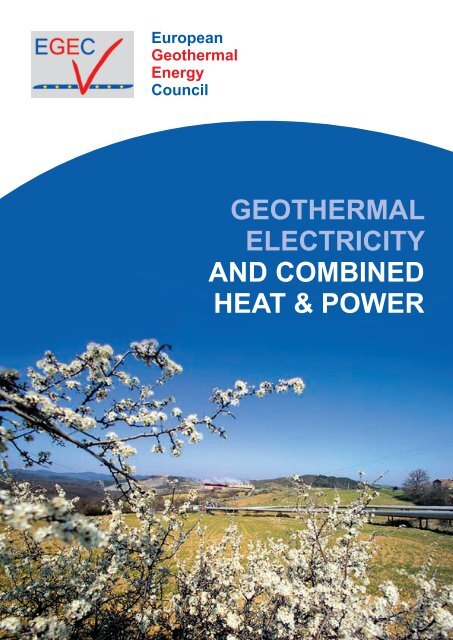

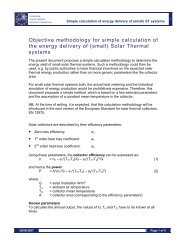
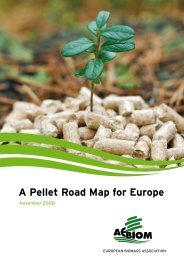
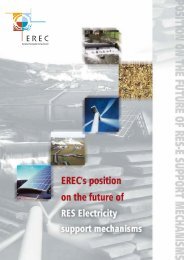

![Energy [R]evolution - Greenpeace](https://img.yumpu.com/47174859/1/184x260/energy-revolution-greenpeace.jpg?quality=85)
